When Can You Start Feeding Puffs
When can babies eat puffs? What about Cheerios? These are just a few of the many questions parents ask themselves when their baby starts transitioning to solid food.
The best period to give your child puffs is somewhere between 7 to 9 months, depending on the baby's development and reaction to finger foods in general.
Cheerios, on the other hand, can be given between 9 to 12 months of age for reasons I'll get into later.
This is also a great period to start practicing the pincer grasp, which is crucial for finger foods.
The main concern parents have with introducing finger food lies in the fact that most of the "first" finger foods are potential choking hazards.
Solid foods, in general, are one of the greatest nightmares for new parents during the first year of a baby's life.
But with the proper research, you can serve your little one delicious meals that are safe and nutritious!
When Can Babies Eat Puffs?
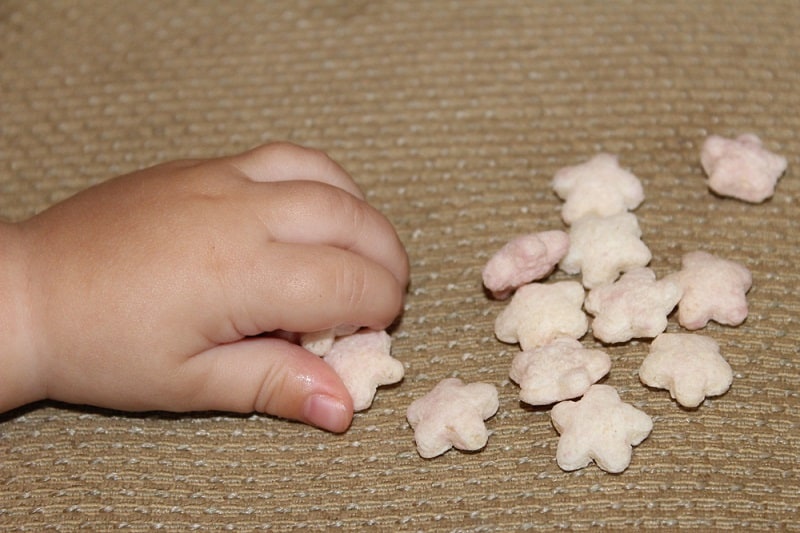
Babies can be introduced to puffs somewhere between 7 and 9 months of age, depending on the overall development of the baby and the food she has been introduced to up to that moment.
Just to be clear, baby puffs are great for food experimentation, but I wouldn't recommend them as the main choice for finger foods.
There are a bunch of brands that sell puffs nowadays, from whole grain to organic puffs and baby cereal that dissolve fast in saliva and decrease the risk of choking.
Although the American Academy of Pediatrics (AAP) recommends baby puffs, they limit them to an occasional snack rather than an everyday meal.
Babies should try various foods to mix up different types of texture, flavors, and nutrients from a young age.
However, that doesn't mean your little one will be ready for all types of food from the start.
The best way to begin with solid foods is to feed your baby with veggies and fruits, as a puree or finger food, depending on whether you've chosen the traditional way of feeding or the baby-led weaning method.
Regarding safety, puffs are definitely among the best finger food ideas because of their ability to dissolve quickly and they're the perfect texture for babies.
However, most baby puffs are nutritionally poor because they're usually just filled with air. Unfortunately, a good flavor doesn't always mean a healthy diet.
Of course, there are some brands that offer a more nutritious product, which is why you should always read labels before buying anything.
Low-nutrient baby puffs don't have to be completely out of the baby's diet – they can still be helpful for the development of fine motor skills.
Generally speaking, puffs can place among the top 10 finger foods you'll give to your little one, although I'd probably leave it at 10th place.
Can puffs be a choking hazard?
There are different types of puffs that have different textures, which is why many parents fear their babies might choke while eating them.
However, most puffs dissolve quickly, minimizing the risk to a very low level.
The best way to ensure there won't be any accidents is to have water nearby in case there's any food stuck in your baby's mouth.
The liquid will also help baby dissolve puffs and cereals more efficiently.
Of course, there's no guarantee that there won't be any accidents (just like with any other type of food) so you should always supervise your baby's mealtimes.
Another way to prevent your little one from choking is by limiting how many puffs she puts into her mouth at once.
You can put a few small pieces on the high chair and refill the tray as needed.
When Do Babies Start With Solids?
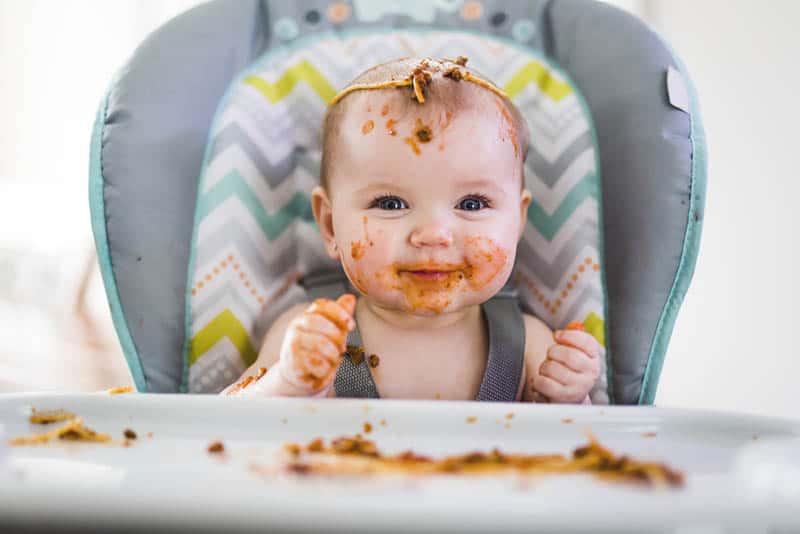
Babies usually start eating solid foods around 6 months of age.
Although some pediatricians claim it's safe to start introducing solids anywhere between 4 and 6 months, the World Health Organization (WHO) doesn't recommend complementary foods (any food or liquid that's not breastmilk) before the age of 6 months.
Breast milk or formula is the main source of energy and nutrients during the first six months of a baby's life.
However, when a baby turns 6 months, breast milk and formula can't meet the needs necessary for healthy development.
That's when most parents start introducing solid foods, also known as complementary foods because they don't represent the main source of nutrients, but rather the new food that will provide the baby with additional energy and proteins.
However, until at least 7 or 8 months of age, it may be still a bit early for questions such as "When can babies eat puffs?"
First baby foods are usually veggie and fruit purees that are completely safe for babies. Some babies experience gagging when eating but in most cases, this is completely normal.
However, even though purees were traditionally considered as the best way to start with solids, things have changed nowadays.
The baby-led weaning (BLW) method has become quite popular among modern parents in the US and the rest of the world.
The main point of the BLW method is letting your child eat finger food by herself. The experience of self-feeding from the beginning of the feeding process allows your little one to enjoy her first finger food at the age of 6 months.
But, there are certain requirements that need to be met in order to start the BLW method:
• The baby should be able to sit unassisted long enough to eat
• The baby can pick up food by herself (without you placing the food in her mouth)
• The baby can swallow the food rather than spitting it out all the time
It's important to offer food that's soft enough for a 6 month old baby, which won't represent a high risk of choking hazard.
RELATED: How To Cut Food For Baby Led Weaning (Tips And Tricks)
Most parents feel frightened at the thought of introducing finger food, which is a completely natural feeling because of the fear of potential choking hazards.
Therefore, the best time to start with finger foods is when you notice your little one is ready for it. You want to start with something soft, such as a boiled carrot, that your little girl can easily chew even without teeth.
Chop the boiled carrot into small pieces and put it on the highchair so your little munchkin can practice the pincer grasp and further develop her fine motor skills.
The pincer grasp is one of the most important developmental milestones within the first year of life. Your baby will start picking up things with her thumb and index finger somewhere between 8-10 months of age, depending on her overall development.
Of course, eating is not the only way to practice this move, but it's one of the most effective ones, for sure.
Grasping an item between your thumb and index finger may sound simple to you, but it's a great achievement for a baby.
One thing to keep in mind is that, no matter how well a baby accepts food, breastfeeding or bottle-feeding should remain the main source of nutrients up to 12 months of age.
Of course, it's highly recommended to continue even after the first year of life, but it doesn't have to be an obligatory part of feeding, as the baby will already get enough from solid foods.
Can My Baby Eat Cheerios?
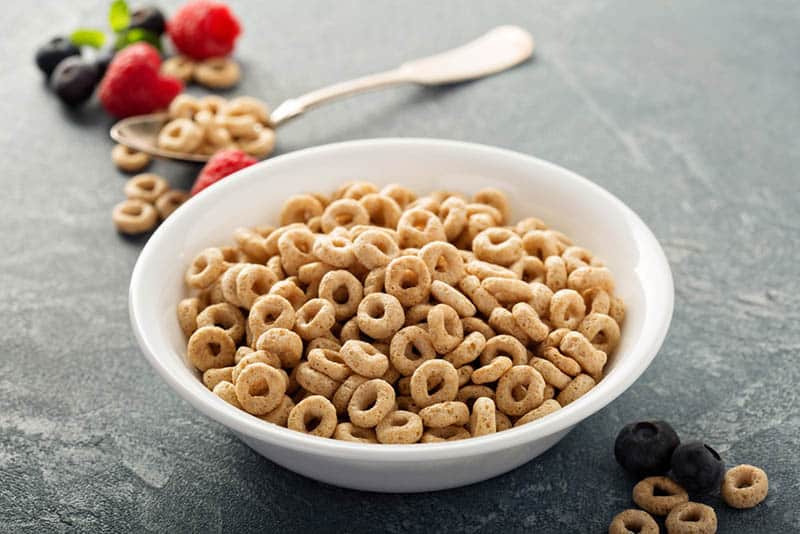
Cheerios are probably one of the most common finger foods and baby snacks that my generation and those before me grew up on.
Of course, everything's changed since then – especially with all the research studies which have become the basis of modern guidelines for feeding babies.
According to these guidelines, Cheerios are appropriate for babies, but there are certain things you need to know about them first.
Just like puffs, these snacks are not recommended as the first finger food for babies. Actually, puffs should be introduced before Cheerios because they dissolve much faster.
As they take a lot more time to dissolve, they can be a potential choking hazard.
Therefore, these baby snacks are recommended somewhere between 9 to 12 months of age.
(Please note: Honey Nut Cheerios should NOT be given to babies.)
The exact time depends on the overall progress of the feeding process and the food your little one has accepted up to that point.
Make sure that your baby is already used to fast-dissolving foods and snacks such as different types of puffs and graham crackers.
Cheerios aren't an essential part of your baby's diet and it'll be perfectly fine if she starts eating them at an older age, as well.
And before you start with these baby snacks, just make sure your little one is comfortable enough with eating different types of food without any difficulties.
A baby should be able to pick up the snack with a pincer grasp, without anyone's help, because the main point of eating these snacks is to further develop fine motor skills.
If your baby gags every time she tries Cheerios, it would be better to postpone until she's able to eat them.
The Best Puffs For Your Baby
Now that you know the answer to: When can babies eat puffs? it's time to take a look at the best puff brands money can buy.
Rice puffs
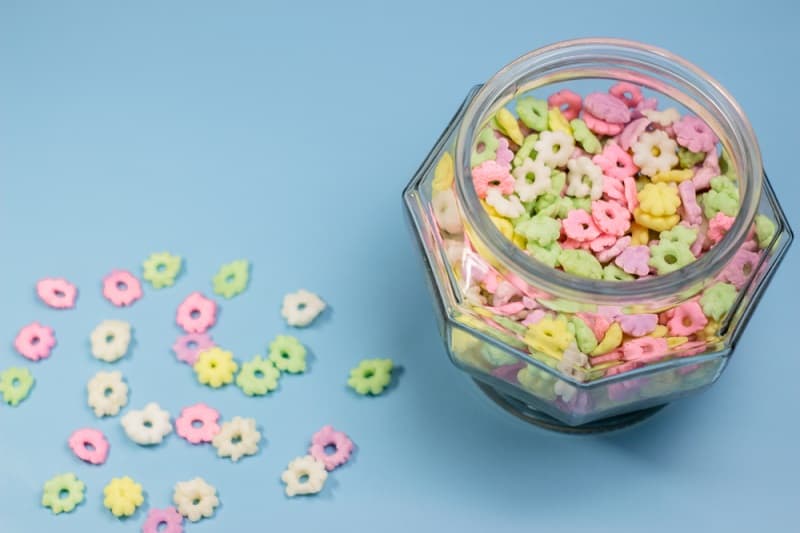
Rice puffs are one of the most common types of puffs that can be found in almost every supermarket or store.
These are considered to be one of the easiest snacks for babies as they dissolve fast, but there are a few things you should keep in mind when it comes to rice.
Rice is widely used in baby food, because of its great benefits for the stomach and digestive system. However, rice is not completely harmless, especially for babies.
It has a high potential to contain a certain quantity of arsenic, which may have a negative impact on the baby. Of course, there won't be any consequences if the baby only eats rice occasionally, but it shouldn't be eaten all the time.
Here are some of the best rice puffs for your baby I'm sure she'll love the first time she tries them:
1. Happy Baby Superfood Puffs

Happy Baby Organics Superfood Puffs
- Superfood Puffs: Parents, meet your pantry's unsung hero Happy Baby Puffs are a melt-in-your-mouth Organic Snack fortified with Choline for eye & brain health Irresistible in taste & texture, they're perfect for teaching babies tactility & self-feeding!
- Organic Snacks For Baby: Happy Baby goes beyond baby food with delicious, Superfood Puffs and freeze-dried yogurt snacks Babies may be ready for our delicious snacks when they can crawl on their hands and knees, without their tummy touching the ground
Prices pulled from the Amazon Product Advertising API on:
Product prices and availability are accurate as of the date/time indicated and are subject to change. Any price and availability information displayed on [relevant Amazon Site(s), as applicable] at the time of purchase will apply to the purchase of this product.
These delicious melt-in-your-mouth puffs ensure your baby gets all the nutrients required for the healthy development of her body and brain.
These puffs are organic and are available in a variety of flavors such as kale and spinach, and sweet potato and carrot.
2. Gerber Graduates Puffs

Gerber Graduates Puffs Cereal Snack
- (Packaging May Vary) Pack of six (6) 1.48 ounce containers of Gerber Puffs
- Includes 2 containers of Gerber Puffs Strawberry Apple, 2 containers of Gerber Puffs Banana and 2 containers of Gerber Puffs Blueberry
Prices pulled from the Amazon Product Advertising API on:
Product prices and availability are accurate as of the date/time indicated and are subject to change. Any price and availability information displayed on [relevant Amazon Site(s), as applicable] at the time of purchase will apply to the purchase of this product.
Gerber is one of the most famous brands when it comes to baby food and snacks which is available in almost every supermarket.
Your kiddo will probably be delighted with the wonderful star shape instead of the classic round puffs. This design also helps the baby easily pick up the puffs by herself.
Gerber puffs are made without any artificial or genetically modified ingredients which means Gerber will be a great choice for those who are looking for a non-GMO brand.
3. Spoonful One Puffs

SpoonfulONE Food Allergen Introduction Puffs
- FOLLOWS USDA RECOMMENDED GUIDELINES for infant nutrition: Introduce your baby to commonly allergenic foods like peanuts, egg, cow milk, tree nuts, wheat, shellfish, fish, and soy starting between 4-6 months.
- THE MOST COMPLETE WAY TO INTRODUCE FOOD ALLERGENS*: SpoonfulONE is the only product that helps your baby grow up accustomed to 16 wholesome, real foods associated with over 90% of food allergies.
Prices pulled from the Amazon Product Advertising API on:
Product prices and availability are accurate as of the date/time indicated and are subject to change. Any price and availability information displayed on [relevant Amazon Site(s), as applicable] at the time of purchase will apply to the purchase of this product.
I'd say these puffs are quite underrated because of the other major brands that have taken over the market.
Spoonful One brand introduces common allergens such as tree nuts, sesame, eggs, peanuts, and shellfish, but in very small doses.
This is a good idea in theory, but in practice, not so much. If you introduce all these allergens at once, how can you know which food caused the allergy? (If your baby does have an allergic reaction.)
My personal recommendation would be to try out most common allergens before using these puffs just to be sure which exact food causes the allergic reaction, if there's any.
However, the brand does claim these puffs are recommended by a large number of pediatricians and allergists.
Puffs without rice
These puffs don't contain rice, which is an ingredient with high levels of heavy metals.
Riceless puffs have excellent flavors your kids will love! Here are the best puffs for your little one:
1. Mission MightyMe Organic Peanut Puffs

Mission MightyMe Organic Proactive Peanut Puffs for Babies & Kids
- ORGANIC PEANUT SNACKS FOR BABIES + BIG KIDS: Mission MightyMe Proactive Peanut Puffs are a yummy, wholesome snack for kids, with the added benefit of making it deliciously simple to follow AAP peanut allergy prevention guidelines for babies. We developed our peanut puffs to dissolve quickly for babies starting solids and taste great for big kids too!
- EARLY PEANUT ALLERGEN INTRODUCTION: Our co-founder Dr. Gideon Lack led the landmark LEAP Study, which showed that starting babies on peanut foods as early as 4-11 months, and continuing until age 5, reduced the risk of developing a peanut allergy by more than 80 percent. Our Proactive Peanut Puffs are a convenient way to introduce and include peanuts in a babys diet early and often.
- ABOUT MISSION MIGHTYME: Founded by parents of children with food allergies and world-renowned pediatric allergist Dr. Gideon Lack, Mission MightyMe is on a mission to help end the food allergy epidemic by making it deliciously simple for parents to follow new pediatric recommendations for including peanuts and other common food allergens in infants die
Prices pulled from the Amazon Product Advertising API on:
Product prices and availability are accurate as of the date/time indicated and are subject to change. Any price and availability information displayed on [relevant Amazon Site(s), as applicable] at the time of purchase will apply to the purchase of this product.
This packaging won my heart over the first time I saw it! It's an adorable representation of a brave young girl that becomes a superhero in her own eyes.
But, the most important thing to mention is that the main ingredient of this snack is peanuts. These puffs will be a great way to introduce peanuts to your kiddo's diet and check if there are any allergies to nuts.
There are no preservatives, added sweeteners, palm oil, or gluten, and no fear over any unhealthy ingredients in your baby's food.
2. Serenity Kids Broccoli & Spinach Puffs

Serenity Kids Broccoli & Spinach Grain Free Puffs
- GRAIN FREE PUFFS • Six 1.5oz containers of Broccoli & Spinach Grain Free Puffs with Bone Broth - a new snacking addition to the Serenity kids line up!
- PERFECT SAVORY BLENDS • Our puffs are savory, not sweet - made with ZERO grams of sugar!
Prices pulled from the Amazon Product Advertising API on:
Product prices and availability are accurate as of the date/time indicated and are subject to change. Any price and availability information displayed on [relevant Amazon Site(s), as applicable] at the time of purchase will apply to the purchase of this product.
Looking for veggie puffs that don't contain grain? Here's one of the best savory snacks for your baby that will help her accept savory food and vegetables more easily.
This snack includes bone broth which contains proteins, as well as organic broccoli, spinach kale, garlic, and parsley.
The best thing about this brand is that it's a family-led company that dedicates time and effort to producing healthy snacks for babies.
3. Puffworks Baby Puffs
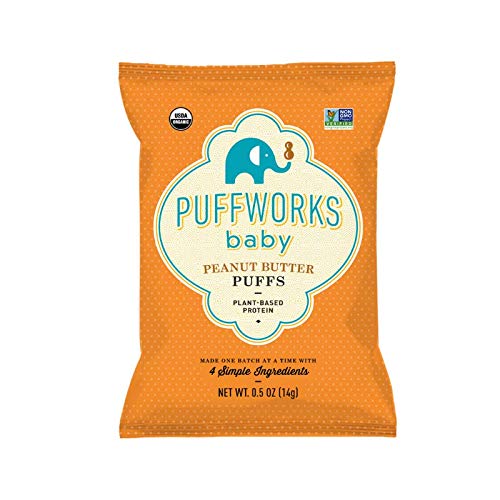
Puffworks Baby Peanut Butter Puffs
- CONTAINS 12, .5 oz bags of Puffworks baby organic peanut butter puffs easy for infants to hold and dissolvable (to prevent choking)
- PLANT-BASED protein (peanuts) made with 50% fresh ground organic peanuts (organic peanut butter) and whole grain corn
- MADE WITH SIMPLE QUALITY INGREDIENTS that are certified USDA organic, non-GMO and gluten free certified
Prices pulled from the Amazon Product Advertising API on:
Product prices and availability are accurate as of the date/time indicated and are subject to change. Any price and availability information displayed on [relevant Amazon Site(s), as applicable] at the time of purchase will apply to the purchase of this product.
Another peanut butter organic snack that doesn't contain gluten or dairy ingredients.
It's a great snack for younger and older babies that includes whole-grain corn and organic peanuts.
You can use them to introduce peanuts to your baby as well and it's a good snack for babies who feed according to the BLW method.
4. Sprout Organic Plant Power Puffs

Sprout Organic Baby Food
- BABY-APPROVED: Plant Power Puffs are a perfect baby cereal snack for babies learning to self-feed; they have a quick-dissolve texture that melts easily, and are gentle on their tummy
- CLEAN INGREDIENTS: Sprout Baby Puffs are USDA certified organic, non-GMO, gluten-free, dairy-free and vegan-friendly; they do not contain any rice, wheat, corn, soy or additives
- NUTRIENT-RICH: Made with just 5 simple ingredients, Sprout Organic Apple Kale Plant Power Puffs include ancient whole grains and real fruits and vegetables
Prices pulled from the Amazon Product Advertising API on:
Product prices and availability are accurate as of the date/time indicated and are subject to change. Any price and availability information displayed on [relevant Amazon Site(s), as applicable] at the time of purchase will apply to the purchase of this product.
It would be a shame not to mention these plant-based puffs that provide your little one with tasty flavors and whole grains which come in BPA-free packaging.
Sprout puffs are non-GMO, free from dairy and gluten, and they're vegan!
It's a great substitution for snacks that contain wheat, soy, rice, or additives.
5. Amara Yogurt Melts

Amara Plant-Based Yogurt Melts
- NO ADDED SUGAR: fruit and vegetable snacks without the sugar crash. In the car or at the park - these melts keep little hands busy and little tummies full.
- SIMPLE INGREDIENTS: Less than 5 ingredients with no added sugars, preservatives or sweetners. Teach your baby and kids the tastes, texture and nutrients of whole fruits and vegetables with these yogurt melt snacks.
Prices pulled from the Amazon Product Advertising API on:
Product prices and availability are accurate as of the date/time indicated and are subject to change. Any price and availability information displayed on [relevant Amazon Site(s), as applicable] at the time of purchase will apply to the purchase of this product.
These fruit and vegetable puffs don't contain any added sugars or other artificial ingredients. What's more, they're easy to chew, even for babies who still have trouble chewing food.
This plant-based snack provides your little one with the energy she needs.
However, I'd still keep them as an occasional snack, because babies and toddlers can easily become used to them and it might be difficult to break the habit.
Final Thoughts
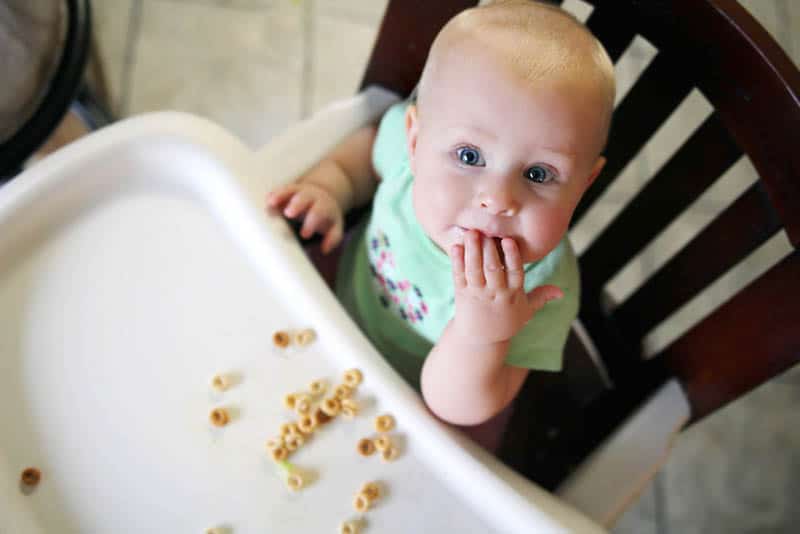
As parents, we all want nothing but the best for our kids, especially when it comes to their diet.
Healthy eating habits start from an early age, which is why it's important to introduce fruits and vegetables before snacks, although many parents ask "When can babies eat puffs?" as soon as the baby turns 6 months of age.
Of course, puffs, cereals, and Cheerios should also be a part of the baby's diet, together with teething biscuits and other snacks which are appropriate during the first year of life.
And even though they're delicious, these snacks should not be a meal replacement.
On the other hand, processed food, including fast foods like hot dogs and hamburgers, as well as cow's milk isn't a good source of nutrients and energy for the baby, although a lot of people have the opposite opinion about milk.
The important thing is, don't be afraid of offering food to your little one – I know the sound of a baby gagging while eating seems scary, but it's nothing dangerous.
Just make sure to recognize the difference between gagging and choking. If your baby has food in her mouth and you realize she can't breathe normally, she probably has a piece of food stuck in her throat.
Also, babies don't need teeth to eat, even when it comes to finger foods. Purees are the safest way to feed your child, but if you offer her food that's soft enough, she'll chew it without any problems.
Last but not least, try to use different brands and flavors, so your little one doesn't get hooked on one type of puffs.
Just remember, Cheerios are not the same thing as puffs and they can't dissolve as fast so they should be introduced after puffs.
Make sure your child already eats other food comfortably before you introduce these cereals.
Most of these puffs and cereals can be found in supermarkets or big box stores, depending on where you live.
I hope you've found the answer to the question: When can babies have puffs? From now on, you can share this knowledge with other parents around you, as well.
Good luck mama, and remember – fruits and veggies first, everything else later.
References:
• World Health Organization. (N.D.). "Complementary Feeding". WHO website.
• Awadalla R. Nicol, Pham Tammy, Milanaik Ruth. (2018, January). "Chew on This: Not All Products Labeled First Finger Foods Are Created Equal". AAP website.
Like this post? Please share or pin it for later. You can also stay in the loop and follow us on Facebook, Instagram or Pinterest.
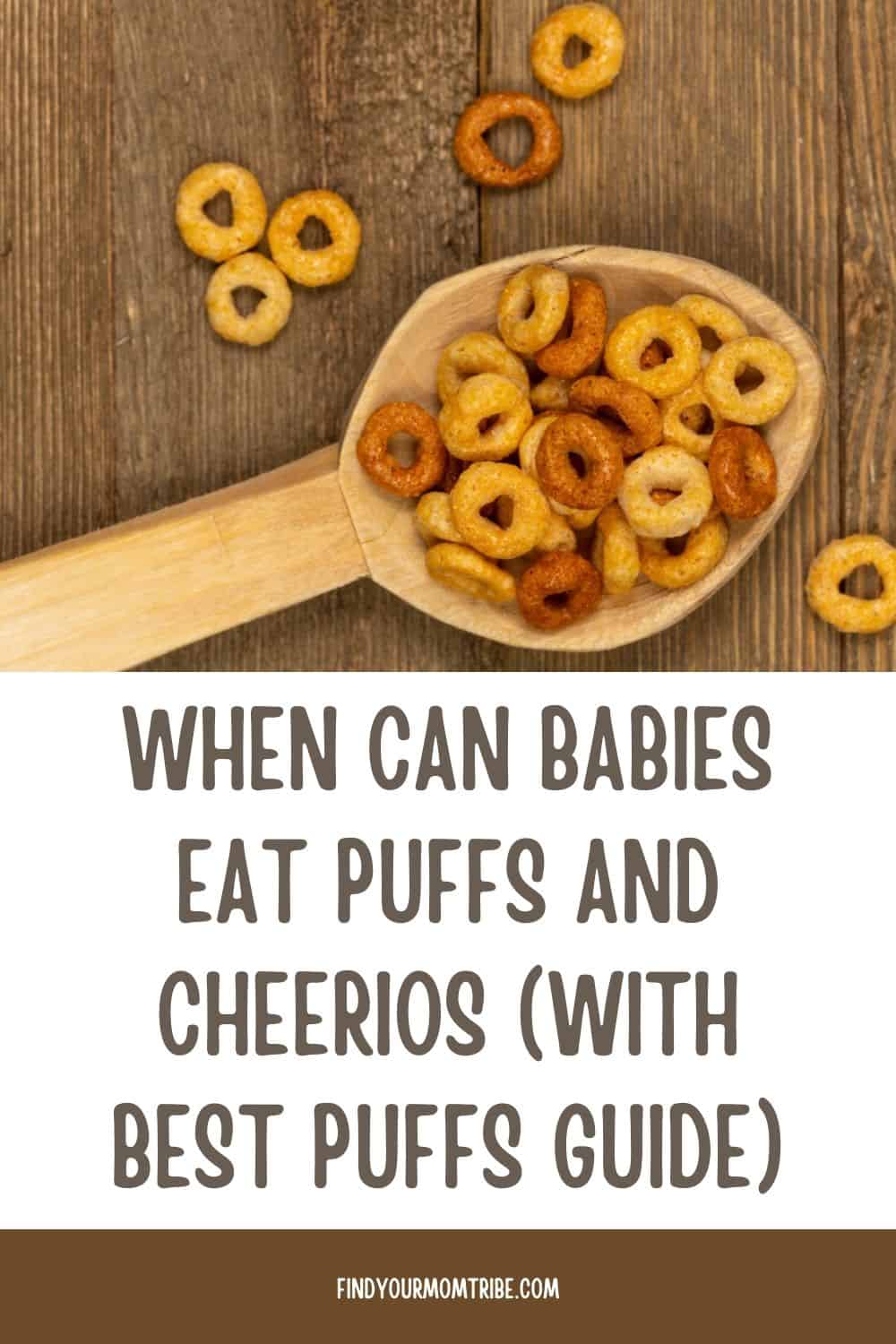
We love honesty! Find Your Mom Tribe is an Amazon Associate and we earn from qualifying purchases through affiliate links at no extra cost to you. Please see our full Amazon Affiliate disclosure for more information.
Source: https://findyourmomtribe.com/when-can-babies-eat-puffs/
0 Response to "When Can You Start Feeding Puffs"
Post a Comment